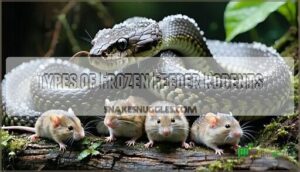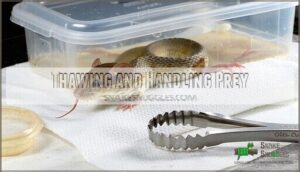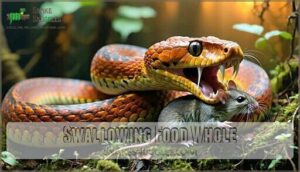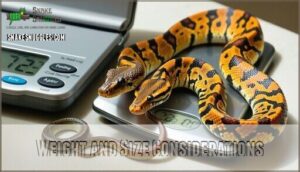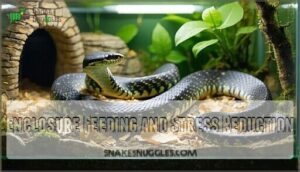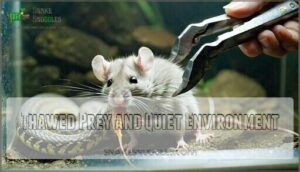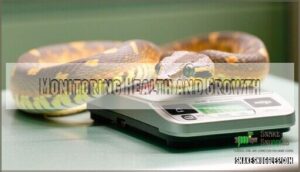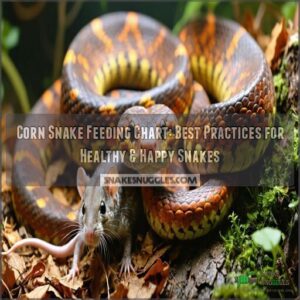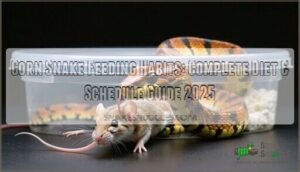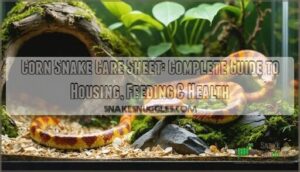This site is supported by our readers. We may earn a commission, at no cost to you, if you purchase through links.
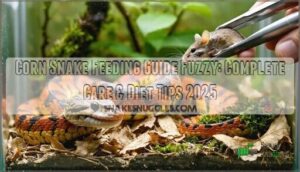
Juveniles aged 3-12 months need fuzzy mice every 7-10 days, while hatchlings stick to pinkies every 5-7 days.
Choose frozen fuzzy mice that match your snake’s thickest body section—think of it like finding the right-sized sweater.
Thaw prey completely in warm water, then use feeding tongs to present it naturally.
Feed in a quiet space to reduce stress, and don’t handle your snake for 48 hours afterward to prevent regurgitation.
The right fuzzy size guarantees healthy growth without overfeeding complications that affect your snake’s well-being and feeding response.
Table Of Contents
- Key Takeaways
- Corn Snake Feeding Basics
- Top 8 Fuzzy Foods for Corn Snakes
- 1. MiceDirect Frozen Fuzzie Mice Snake Food
- 2. MiceDirect Frozen Rat Fuzzies Snake Food
- 3. MiceDirect Frozen Mice Snake Food Combo
- 4. Small Frozen Mice Snake Food
- 5. MiceDirect Frozen Pinkies and Fuzzies
- 6. MiceDirect Frozen Small Fuzzie Feeders
- 7. Frozen Mice Fuzzies and Hoppers
- 8. Safari Corn Snake Toy Figurine
- Prey Size and Type Selection
- Nutritional Needs and Health
- Feeding Techniques and Environment
- Monitoring Health and Growth
- Frequently Asked Questions (FAQs)
- Do corn snakes eat Fuzzies?
- Do corn snakes need a feeding chart?
- How do you know if a corn snake is hungry?
- Can you feed corn snakes frozen prey?
- What should I do if my Corn Snake refuses to eat?
- How do you feed a corn snake a rodent?
- How often should I feed my corn snake a fuzzy?
- Can a corn snake eat fuzzies?
- What are fuzzies feeding snakes?
- Can a corn snake eat a fuzzy mouse?
- Conclusion
Key Takeaways
- You’ll feed juvenile corn snakes (3-12 months) fuzzy mice every 7-10 days, switching from pinkies once they reach 25-30 grams
- Choose fuzzy mice that match your snake’s thickest body section – they should be 1-1.5 times wider than your snake’s body for safe digestion
- Thaw frozen fuzzies completely in warm water for 15-30 minutes, then use feeding tongs to present them in a quiet environment
- Don’t handle your snake for 48 hours after feeding to prevent regurgitation and allow proper digestion
Corn Snake Feeding Basics
Feeding your corn snake the right-sized fuzzy mice at proper intervals guarantees healthy growth and prevents digestive problems.
Understanding your snake’s age, size, and seasonal feeding patterns helps you create a feeding schedule that supports ideal development throughout their life, ensuring proper care.
Feeding Frequency by Age
Your corn snake’s age determines how often you’ll need to feed them.
Hatchling frequency requires meals every 5-7 days to support rapid growth during their first six months.
Juvenile schedules shift to weekly feeding intervals as they develop.
Adult intervals extend to every 10-14 days once they reach maturity.
Senior feeding may require slight adjustments based on metabolism and activity levels.
Feeding Frequency by Size
Your snake’s size determines how often you’ll fill that food bowl.
Here’s your size-based feeding roadmap:
- Hatchlings (8-20 inches): Feed every 5-7 days with pinkie mice
- Juveniles (20-45 inches): Switch to 7-10 day intervals using fuzzy mouse size
- Subadults (35-50 inches): Extend to 10-12 days between meals
- Adults (35+ inches): Feed every 14-21 days to prevent obesity
- Senior corn snakes: Maintain 10-14 day adult intervals with size adjustments
Weight matters more than length—monitor your baby corn snake‘s growth and adjust accordingly.
Captive corn snakes benefit from a diet of pre-killed prey for safety.
Seasonal Changes and Feeding Habits
Your snake’s appetite changes throughout the year as temperatures shift. During winter brumation, feeding habits slow substantially – you’ll notice reduced appetite and longer intervals between meals.
Summer activity peaks bring increased feeding frequency as your snake’s metabolism ramps up. Breeding season also affects appetite, with females often refusing food before laying eggs.
Temperature impact directly controls these seasonal changes in feeding patterns and shedding cycles. It’s important to note that frozen feeders are safer than live prey, which is a key factor in your snake’s overall health and feeding habits.
Top 8 Fuzzy Foods for Corn Snakes
When you’re selecting fuzzy mice for your juvenile corn snake, quality and proper sizing make all the difference in your pet’s health and growth.
These eight top-rated fuzzy food options provide the nutrition your snake needs while ensuring safe, stress-free feeding experiences.
1. MiceDirect Frozen Fuzzie Mice Snake Food
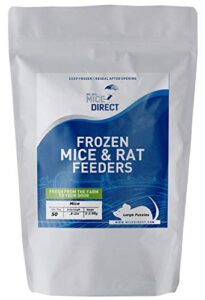
Premium quality meets convenience with MiceDirect’s frozen fuzzie mice.
These 50-count packages deliver farm-fresh rodents weighing 3-6.99 grams each, perfect for juvenile corn snakes.
You’ll appreciate the humane CO2 euthanization and Mazuri feed nutrition that guarantees disease-free prey.
Each mouse measures 1.50-1.75 inches, providing ideal portion control.
The dry ice packaging guarantees frozen delivery from Cleveland, GA farms within a week of processing.
Best For: Reptile owners with juvenile corn snakes, ball pythons, or other small to medium snakes who want premium, humanely-raised frozen prey.
- Humanely raised on high-quality Mazuri feed and CO2 euthanized for optimal nutrition and ethics
- Farm-fresh delivery with dry ice packaging ensures frozen arrival within a week of processing
- Consistent sizing (3-6.99g, 1.50-1.75") provides ideal portion control for juvenile snakes
- Smaller than expected size may require multiple mice per feeding for larger snakes
- Higher cost compared to typical pet store frozen mouse options
- Some customers report mixed experiences with product consistency
2. MiceDirect Frozen Rat Fuzzies Snake Food
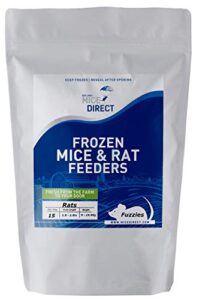
Quality matters when choosing rat fuzzies for your growing corn snake.
MiceDirect’s frozen rat fuzzies come from Cleveland, GA, where they’re raised on Mazuri zoological-grade feed and humanely processed with CO2.
Each fuzzy weighs 9-19.99 grams and measures 2-2.5 inches, perfect for juveniles making the switch from pinkies.
They arrive frozen in dry ice within a week of processing.
However, rat fuzzies have higher fat content than mice, so they’re not ideal for adult corn snakes or regular feeding.
Best For: Juvenile corn snakes, hognose snakes, and sand boas transitioning from pinkies to larger prey items.
- Raised in Cleveland, GA on premium Mazuri zoological-grade feed for optimal nutrition
- Humanely processed with CO2 method and delivered frozen within one week for maximum freshness
- Perfect size (9-19.99g, 2-2.5 inches) for growing juveniles making the transition from smaller prey
- Higher fat content makes them unsuitable for regular feeding or adult corn snakes
- More expensive than standard pet store alternatives according to some customer feedback
- Some snakes may have difficulty accepting due to size or texture differences compared to mice
3. MiceDirect Frozen Mice Snake Food Combo
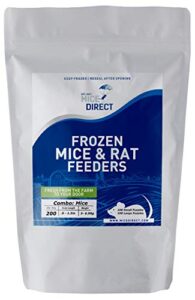
Smart shoppers know that variety matters when your corn snake grows.
This combo pack delivers 100 small fuzzies and 100 regular fuzzies, giving you options as your snake shifts between sizes.
You won’t need separate orders since both sizes arrive together from Cleveland, GA.
The vacuum-sealed packaging prevents freezer burn, while CO2 euthanasia guarantees humane sourcing.
At 3-6.99 grams each, these mice provide the perfect stepping stones for growing juveniles, offering a humane way to feed your pet.
Best For: Corn snake owners with growing juveniles who need both small and regular fuzzy sizes for transitional feeding stages.
- Combo pack provides two sizes in one shipment, eliminating need for separate orders as snakes grow
- Vacuum-sealed packaging prevents freezer burn and maintains freshness during storage
- Humane CO2 euthanasia and USDA-inspected sourcing ensures ethical, high-quality feeder mice
- Limited to specific size range (3-6.99 grams) may not suit all snake species or growth stages
- Requires freezer space for 200 mice, which may be challenging for smaller households
- One-week delivery time from euthanasia may not work for immediate feeding needs
4. Small Frozen Mice Snake Food

Fourth on our list delivers consistent quality frozen mice ranging from 10-14 grams, perfect for juvenile corn snakes making the shift from fuzzies.
You’ll appreciate the balanced 55% protein and 23% fat content that supports steady growth.
These pre-weaned mice arrive frozen in resealable bags from USDA-certified facilities, ensuring safety and freshness.
The 1.4:1 calcium-phosphorus ratio promotes healthy bone development during your snake’s critical growth phase.
Best For: Juvenile corn snakes transitioning from fuzzies to adult prey sizes who need consistent nutrition for healthy growth.
- Limited to one size range (10-14g) requiring multiple product purchases as snake grows
- Requires advance planning for thawing time (2-5 hours at room temperature)
- May need calcium supplementation if used exclusively during early growth stages
- USDA-certified facility ensures safe, high-quality frozen mice with reliable freshness
- Optimal 55% protein and 23% fat content supports steady juvenile snake growth
- Convenient frozen storage eliminates live prey risks and feeding schedule disruptions
5. MiceDirect Frozen Pinkies and Fuzzies
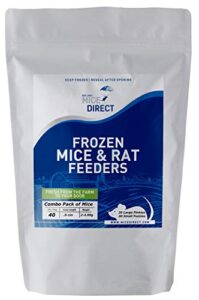
You’ll appreciate this premium 40-piece combo pack that combines 20 pinkies with 20 small fuzzies.
Each feeder measures 0.5-1 inches and weighs 2-3.99 grams, making them perfect for growing corn snakes shifting between prey sizes.
These Cleveland, GA-raised mice receive Mazuri zoological grade feed without artificial additives.
The CO2 euthanization method guarantees humane treatment, while dry ice packaging guarantees they arrive frozen and fresh for superior nutrition.
Best For: Reptile owners with young or juvenile corn snakes needing appropriately-sized frozen prey during growth transitions.
- Humane CO2 euthanization and premium Mazuri feed ensure ethical sourcing and superior nutrition
- Combo pack provides two sizes (pinkies and fuzzies) for snakes transitioning between feeding stages
- Dry ice packaging and direct farm shipping guarantee frozen freshness upon arrival
- Limited to smaller prey sizes, requiring future purchases as snakes grow larger
- Shipping costs may be high due to dry ice requirements and expedited delivery needs
- Week-long processing time from euthanasia to delivery may not suit urgent feeding schedules
6. MiceDirect Frozen Small Fuzzie Feeders
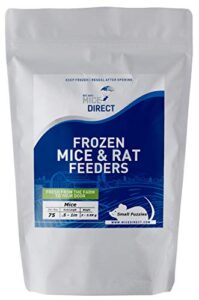
MiceDirect’s frozen small fuzzie feeders offer premium quality for your growing corn snake.
These 2-3 gram mice from Cleveland, GA arrive fresh-frozen with dry ice packaging, ensuring ideal nutrition.
You’ll appreciate their humane CO2 euthanization process and Mazuri zoological-grade feed diet.
They’re perfect for shifting juveniles from pinkies, though some customers note they’re smaller than expected.
Their consistent sizing and disease-free guarantee make feeding schedules predictable and safe for your snake’s development.
Best For: Reptile owners with juvenile corn snakes, hognose snakes, or milk snakes who need consistent, premium-quality frozen feeders for transitioning from pinky mice.
- Mice are smaller than expected and closer to large pinky size rather than typical fuzzie dimensions
- Premium pricing reflects convenience and quality, making them more expensive than standard options
- Occasional shipping damage may result in snapped limbs or tails, though packaging is generally well-regarded
- Premium quality with humane CO2 euthanization and Mazuri zoological-grade feed ensuring optimal nutrition
- Reliable dry ice packaging and fast shipping guarantee fresh arrival within about one week of processing
- Disease-free guarantee and consistent sizing make feeding schedules predictable and safe for snake development
7. Frozen Mice Fuzzies and Hoppers
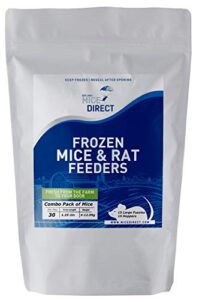
When shifting your growing corn snake to larger prey, frozen mice fuzzies and hoppers provide the perfect stepping stone.
These combo packs offer excellent nutritional value with higher protein and fat content than pinkies.
You’ll find hoppers especially beneficial for juveniles exceeding 18-20 inches, as their developed bones increase calcium intake.
The variety helps prevent feeding monotony while supporting healthy growth rates of 1-3 inches monthly in active juveniles, ensuring a balanced diet with higher protein.
Best For: Corn snake owners transitioning juveniles from pinkies to larger prey, especially for snakes exceeding 18-20 inches that need higher protein and calcium content.
- Higher protein and fat content than pinkies, supporting healthy growth rates of 1-3 inches monthly in active juveniles
- Hoppers provide increased calcium intake due to developed bones, essential for proper skeletal development
- Combo pack variety prevents feeding monotony while ensuring nutritionally balanced whole prey diet
- Requires proper thawing to room temperature to avoid digestive issues or regurgitation in snakes
- Limited to specific size range – only suitable for small to medium reptiles weighing 4-13.99 grams
- Higher cost compared to basic pinkie mice due to premium sourcing and specialized shipping requirements
8. Safari Corn Snake Toy Figurine
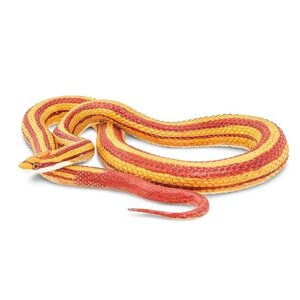
While this realistic toy won’t satisfy your corn snake’s appetite, Safari’s corn snake figurine serves as an excellent educational tool for reptile enthusiasts.
Hand-painted with authentic striped patterns and natural coiling pose, this 5.25-inch model accurately represents Pantherophis guttatus coloring and scale details.
Made from non-toxic, BPA-free PVC, it’s perfect for teaching children about snake anatomy and habitat needs.
Remember to research proper enclosure setup before considering a real corn snake.
Though you can’t bend its fixed shape, the figurine’s vibrant colors and realistic proportions make it ideal for classroom demonstrations or collector displays.
Best For: Educators, collectors, and parents seeking a realistic, educational corn snake model for teaching reptile identification and anatomy.
- Fixed coiled shape cannot be repositioned or bent for different poses or displays
- Size may disappoint some customers who expect larger dimensions despite the 5.25-inch measurement
- Durability concerns with some reports of breakage, though generally well-constructed for intended use
- Hand-painted with authentic striped patterns and accurate anatomical proportions based on real Pantherophis guttatus specimens
- Made from high-quality, non-toxic BPA-free PVC that’s safe for children ages 3 and meets safety standards
- Excellent educational tool for classroom demonstrations, biology projects, and teaching snake identification skills
Prey Size and Type Selection
Choosing the right prey size and type forms the foundation of successful corn snake feeding.
You’ll need to match fuzzy mice to your snake’s current size and growth stage, ensuring proper nutrition while preventing feeding complications.
Types of Frozen Feeder Rodents
When selecting from four main frozen feeder types—mice, rats, gerbils, and hamsters—mice dominate corn snake diets.
Fuzzies (10-13g for mice, 15-25g for rats) offer developing fur and higher protein than pinkies.
Captive-bred prey eliminates parasites while providing consistent rodent nutritional value, and multiple prey items work when single feeders prove inadequate sizing, which is a key aspect of using captive-bred prey.
Thawing and Handling Prey
You’ll thaw frozen-thawed mice safely using proper thawing techniques in warm water for 15-30 minutes.
Never microwave prey items, as this creates dangerous hot spots.
Using safe thawing practices is essential to prevent bacterial growth.
Use feeding tongs during the feeding process to present prey at the right temperature while maintaining safe handling practices.
Always wash your hands thoroughly after touching prey to follow proper hygiene practices.
Prey Size and Snake Growth
Proper prey size directly impacts your corn snake’s growth and development. Research shows snakes offered appropriately sized prey reach adult length 10-12 months sooner than those given undersized meals.
Many owners source their frozen reptile feeders online for convenience.
- Growth Stages: Hatchlings need pinkies, juveniles require fuzzies, adults eat hoppers or adult mice
- Prey Dimensions: Choose prey 1-1.5 times your snake’s widest body section
- Fuzzy Shift: Switch to fuzzies when your snake weighs 25-30g
- Multiple Prey: Offer several smaller items if single prey seems inadequate
Swallowing Food Whole
Corn snakes don’t chew their food like you might expect.
Instead, they rely on jaw flexibility and esophagus flexibility to swallow prey whole.
Your snake’s jaw unhinging allows it to consume meals larger than its head width.
The digestive process begins immediately as powerful stomach acids break down bones and tissue.
Scale protection prevents internal damage during swallowing.
Monitor swallowing speed to identify potential aspiration risks during snake feeding sessions.
Weight and Size Considerations
Weight monitoring serves as your compass for healthy feeding practices.
Track your snake’s weight every 2-4 weeks to guarantee proper growth without obesity.
The prey should create a barely visible bulge that disappears within 24 hours—anything larger risks regurgitation.
Maintain feeding logs to record weight changes, prey size adjustments, and growth patterns for ideal health monitoring.
Nutritional Needs and Health
Your corn snake’s nutritional health depends on the right balance of vitamins, minerals, and hydration from whole prey items.
Understanding these essential nutrients helps you maintain your snake’s vibrant skin, strong bones, and overall well-being.
Vitamin a and Skin Health
Your corn snake needs vitamin A from mice liver for healthy skin shedding and clear eyes.
Deficiency symptoms include retained shed, cloudy eyes, and poor scale quality.
Whole prey provides adequate vitamin sources naturally.
Supplementation risks include overdose toxicity.
Monitor skin hydration and scale quality regularly.
Proper UVB lighting also aids in Vitamin D3 synthesis.
Proper reptile nutrition prevents nutritional deficiencies without additional vitamin requirements or malnutrition concerns.
Whole Prey and Essential Minerals
Feeding whole prey items provides your corn snake with a complete nutritional profile that supplements can’t match.
Captive-bred prey delivers calcium, phosphorus, and other mineral sources naturally found in bones, organs, and tissues.
This rodent variety guarantees your snake’s nutritional needs are met without additional supplement needs.
The nutritional values of whole prey help prevent health issues like metabolic bone disease that occur when snakes lack proper mineral intake, ensuring a healthy diet.
Fresh Water and Hydration
Your snake needs constant access to clean water through a properly sized water bowl.
Fresh water supports hydration during shedding and helps maintain proper humidity levels in the enclosure.
Monitor for dehydration signs like wrinkled skin or sunken eyes, and make certain your water source stays clean to prevent bacterial growth, ensuring your snake’s environment remains healthy by providing clean water.
Balanced Diet and Supplements
Whole rodents provide complete nutritional needs for your corn snake without requiring supplements.
You’ll find calcium naturally present in bones, while Vitamin A comes from organs.
However, fast-growing juveniles may benefit from light calcium and multivitamin dusting every 2-4 meals.
Always maintain proper hydration importance through fresh water.
Monitor for obesity risks by tracking your snake’s body condition and weight regularly to guarantee proper nutritional balance and maintain healthy conditions.
Feeding Techniques and Environment
Creating the right feeding environment reduces stress and guarantees your corn snake digests properly.
You’ll need proper thawing techniques, feeding tongs, and a quiet space to help your snake feel secure during meals.
Enclosure Feeding and Stress Reduction
Your pet’s home becomes their dinner table when you feed inside the enclosure.
This approach minimizes handling stress and maintains ideal temperatures for proper digestion. A quiet environment during meals helps your snake focus on eating without distractions.
- Feeding Schedule: Establish consistent meal times to reduce anxiety and create predictable routines
- Handling Reduction: Keep interactions minimal before and after feeding to prevent stress-induced regurgitation
- Post-Meal Privacy: Provide undisturbed spaces where your snake can digest peacefully for 24-48 hours
Enclosure feeding creates a stress-free feeding environment that supports your corn snake’s natural behaviors while ensuring feeding safety.
Feeding Tongs and Natural Movement
When using feeding tongs, you’ll protect yourself while stimulating your corn snake’s natural hunting instincts.
Proper tongs safety prevents accidental bites during prey presentation. The gentle wiggling motion mimics live prey movement, encouraging feeding behavior and reducing stress during meals.
Many retailers offer a variety of options suitable for different snake sizes.
| Tong Type | Safety Level | Natural Movement |
|---|---|---|
| Plastic Tongs | Moderate | Limited flexibility |
| Metal Tongs | High | Precise control |
| Bamboo Tongs | Low | Natural feel |
| Long Tongs (12") | Excellent | Safe distance |
| Short Tongs (6") | Good | Close handling |
Thawed Prey and Quiet Environment
Proper thawing methods make all the difference in successful corn snake feeding.
You’ll want to thaw frozen mice in warm water for 15-30 minutes, never using microwaves which create dangerous hot spots.
Follow thawing guidelines that guarantee prey reaches room temperature throughout.
Create a calm feeding environment by dimming lights and minimizing noise during prey presentation.
This reduces stress for your snake and encourages natural feeding responses.
Safe handling means using tongs for frozen-thawed mice delivery while maintaining your established feeding schedule consistently, which is crucial for successful corn snake feeding and helps in creating a calm feeding environment and ensuring natural feeding responses.
Post-Meal Care and Hygiene
After feeding, maintain your snake enclosure’s temperature and humidity to prevent regurgitation risks and guarantee proper prey digestion.
Avoid handling for 48-72 hours to allow undisturbed digestion.
Remove any spoiled prey within an hour to prevent bacterial growth.
Practice good hygiene practices by washing hands thoroughly after handling feeders, and monitor your snake’s postmeal behavior for any concerning signs during this critical digestion period.
Monitoring Health and Growth
Monitoring your corn snake’s health requires consistent weight tracking and careful observation of feeding responses.
You’ll need to weigh your snake every 2-4 weeks and watch for signs like refused meals, abnormal shedding, or changes in behavior that signal potential health issues.
You should also be aware of signs like refused meals, which can indicate potential problems.
Weight Tracking and Growth Charts
Weight monitoring becomes your crystal ball for predicting your corn snake’s health journey. Track weekly measurements using a gram scale to spot growth trends early.
Here’s your tracking toolkit:
- Growth Rate: Juveniles gain 2g weekly under ideal conditions
- Weight Milestones: Introduce fuzzies when snakes reach 25-35g
- Feeding Adjustments: Use charting tools to modify schedules based on growth patterns
Your feeding chart reveals health indicators through consistent data collection. Document corn snake growth alongside prey sizes to identify when your snake size requires different nutrition. Accurate measurements require a reptile gram scale.
Sharp deviations from established growth and development curves signal feeding schedule changes.
Signs of Health Issues and Veterinary Help
Several key lethargy signs signal when you’ll need veterinary help for your corn snake.
Watch for refusal reasons like consistently declining food for over two weeks, abnormal shedding patterns, and significant weight changes.
Health issues requiring vet consultation include regurgitation, rapid weight loss, and unusual behavior patterns.
| Warning Signs | When to Call Vet | Urgent Symptoms |
|---|---|---|
| Food refusal 2+ weeks | Persistent regurgitation | Severe weight loss |
| Lethargy, no movement | Abnormal shedding stuck | Respiratory distress |
| Unusual discharge | Open mouth breathing | Visible injuries |
| Scale discoloration | Tremors or seizures | Blood in waste |
A reptile veterinarian specializes in snake health issues and can diagnose problems you might miss.
Regular Observation and Early Issue Detection
You’ll spot trouble before it becomes serious by watching your snake’s daily habits.
Monitor feeding response monitoring closely—healthy corn snakes strike enthusiastically and swallow completely.
Look for behavioral changes like lethargy or hiding excessively.
Check for shedding problems such as stuck shed on eyes or tail tips.
Track weight fluctuations monthly using a digital scale.
Watch body condition—ribs shouldn’t show, but avoid overfeeding.
Notice regurgitation signs immediately and document feeding concerns for your veterinarian.
Adjusting Feeding Intervals and Prey Size
As your corn snake grows, you’ll need to adjust feeding intervals and prey size to match their changing needs.
Age-Based Adjustments mean juveniles shift from weekly feeds to 10-14 day intervals as adults.
Size-Based Adjustments guarantee rodent size matches your snake’s width perfectly.
- Juvenile corn snake: Weekly feeding with fuzzy mice
- Adult corn snake: 10-14 day feeding intervals
- Metabolic Rate decreases with age, requiring longer intervals
- Seasonal Feeding adjustments during cooler months
- Prey Progression from pinkies to adult mice over time, which is a key part of Size-Based Adjustments and Age-Based Adjustments, ensuring proper Metabolic Rate management.
Frequently Asked Questions (FAQs)
Do corn snakes eat Fuzzies?
Yes, corn snakes absolutely eat fuzzies.
Think of it as their growing-up meal.
You’ll feed fuzzies to juvenile snakes weighing 25-30 grams who’ve outgrown pinkies but aren’t ready for adult mice yet.
Do corn snakes need a feeding chart?
You’ll benefit from keeping a feeding chart to track your corn snake’s weight, prey size, feeding dates, and growth patterns.
This record helps you adjust feeding schedules and identify potential health issues early.
How do you know if a corn snake is hungry?
Like a restless spirit prowling its domain, you’ll notice your snake actively exploring its enclosure, tongue-flicking more frequently, and showing increased alertness when you approach—classic hunger signals.
Can you feed corn snakes frozen prey?
You’ll want to use frozen-thawed prey since it’s much safer than live feeding.
Thaw frozen fuzzies completely in warm water, then use feeding tongs to present them safely to your snake.
What should I do if my Corn Snake refuses to eat?
Wondering why your scaly friend suddenly turned picky?
Check your husbandry first—temperature, humidity, and stress levels affect appetite.
Offer smaller prey, try different feeding techniques, or wait through natural fasting periods before consulting a reptile veterinarian.
How do you feed a corn snake a rodent?
Thaw frozen rodent in warm water for 15-30 minutes.
Use feeding tongs to present prey safely, wiggling it to trigger hunting response.
Feed in quiet environment, then leave snake undisturbed for proper digestion.
How often should I feed my corn snake a fuzzy?
Looking for the right feeding schedule for your fuzzy-eating corn snake? Feed juvenile corn snakes one fuzzy mouse every 5-7 days to support their rapid growth and development needs effectively.
Can a corn snake eat fuzzies?
Yes, corn snakes can eat fuzzies.
Juveniles around 25-30 grams switch from pinkies to fuzzy mice.
Fuzzies should be 1-5 times your snake’s widest body section for proper digestion and growth.
What are fuzzies feeding snakes?
Fuzzies are absolutely essential baby mouse prey items that’ll become your corn snake’s next meal after they outgrow pinkies.
These fuzzy-haired rodents weigh around 3-10 grams and provide perfect nutrition for growing juveniles moving to larger prey sizes.
Can a corn snake eat a fuzzy mouse?
Corn snakes can definitely eat fuzzy mice when they’re the right size.
You’ll want to make certain the fuzzy is 1-5 times your snake’s widest body part for safe digestion and growth.
Conclusion
Following your corn snake feeding guide fuzzy protocol guarantees healthy growth and proper nutrition.
You’ve learned proper prey sizing, thawing techniques, and feeding schedules that match your snake’s age and development.
You’ll maintain consistent feeding intervals, monitor your pet’s weight, and create stress-free feeding environments.
Remember to use feeding tongs and allow adequate post-meal rest periods to support your corn snake’s long-term health and natural feeding behaviors throughout its life.
- https://www.reddit.com/r/cornsnakes/comments/1807aso/mice/
- https://www.petmd.com/reptile/corn-snake-care-sheet
- https://exoticdirect.co.uk/news/feeding-corn-snakes/
- https://community.morphmarket.com/t/should-i-feed-2-pinkies-at-once-or-1-pinky-more-frequently/42352
- https://www.youtube.com/watch?v=eyhauAOwa9o

